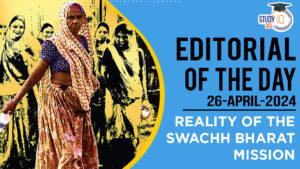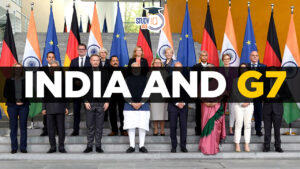Daily Current Affairs for UPSC 2022
Q) Recently seen in news, the term ‘baguette’ is best described by which one of the following:
- A basket made out of bamboo by Gond tribes in Madhya Pradesh.
- A wheat bread loaf listed as intangible cultural heritage by UNESCO.
- A traditional head dress made by the Naga tribes in India.
- A unique fabric woven from silk obtained from lotus stems.
Daily Current Affairs for UPSC – 2 December 2022
Explanation:
- Option (2) is correct: Baguette is the staple French bread which has been inscribed into the UNESCO’s list of intangible cultural heritage (ICH).The baguette is a long and thin loaf made of flour, water, salt and yeast, and is consumed as a staple in France. Some believe that it was invented by August Zang, a baker and an entrepreneur from Vienna in 1839, who introduced the world to the taste of crusty bread with softer insides, using a steam oven. It gained its official name in 1920. The history of the bread is uncertain, some also believe that Napoleon Bonaparte ordered thin sticks of bread for consumption by his soldiers as they could be carried from one place to another more conveniently.
Q) With reference to the Great Hornbill, consider the following statements:
- It is endemic to north-eastern states in India.
- The highest density of hornbills across Asia is found in Namdapha National Park in Arunachal Pradesh.
- It is listed as Vulnerable in the IUCN red list.
Which of the statements given above is/are not correct?
- 1 only
- 1 and 2 only
- 2 and 3 only
- 1 and 3 only
Explanation:
- Statement 1 is incorrect: The largest hornbill species in India, Great Hornbills are also called Great Indian or Great Pied Hornbills. In India they are mainly found in the foothills of the Himalayas and parts of northeast India, along with the Western Ghats. These striking birds measure 95 to 130cm in length and are identified by their black and white plumage and their large, curved beaks. There are about 62 hornbill species world-over. India is home to nine of them including the Great Hornbill, the Malabar Pied Hornbill and the Rufous-necked Hornbill.
- Statement 2 is correct: Namdapha National Park in Arunachal Pradesh houses the highest density of hornbills across Asia. Western Ghats alone are home to four of the nine hornbill species, of which the Great Hornbill is the most prominent. Hornbills play a vital role in forest regeneration and are therefore called ‘farmers of the forest’. They are omnivores, but they have a preference for fruits, particularly figs. They are known to disperse seeds and aid in the regeneration of tropical trees.
- Statement 3 is correct: Great Hornbill is listed as Vulnerable under the IUCN Red List. Apart from deforestation and habitat fragmentation, their populations are also significantly impacted by hunting. Myths about the medicinal value of their meat and an interest in their large casques make them frequent targets. Hornbill Festival is organized by the Government of Nagaland, to showcase Nagaland’s deep-rooted traditions and its rich cultural heritage in all its ethnicity, diversity, and grandeur.
Q) Which of the following are listed as India’s Intangible Cultural Heritage in the UNESCO list?
- Garba dance
- Kuttiyattam
- Mudiyettu
- Chhau dance
Select the correct answer using the code given below:
- 1 and 3 only
- 1, 2 and 4 only
- 2, 3 and 4 only
- 1, 2, 3 and 4
Explanation:
- Option (3) is correct: UNESCO’s Intangible cultural heritage includes “oral traditions, performing arts, social practices, rituals, festive events, knowledge, and practices concerning nature and the universe or the knowledge and skills to produce traditional crafts.” List of Intangible Cultural Heritage in India includes:Buddhist Chanting, Kalbelia, Chhau Dance, Koodiyattam, Kumbh Mela, Mudiyettu, Nawruz, Ramlila, Sankirtana, Ramman, Traditional Brass and Copper Craft of Utensil making, Vedic Chanting, Yoga, Durga Puja.
- Chhau dance is a tradition from eastern India that enacts episodes from epics including the Mahabharata and Ramayana, local folklore and abstract themes. Its three distinct styles hail from the regions of Seraikella, Purulia and Mayurbhanj, the first two using masks. Chhau dance is intimately connected to regional festivals, notably the spring festival Chaitra Parva. Its origin is traceable to indigenous forms of dance and martial practices.
- Mudiyettu is a ritual dance drama from Kerala based on the mythological tale of a battle between the goddess Kali and the demon Darika. It is a community ritual in which the entire village participates. Mudiyettu is performed annually in ‘Bhagavati Kavus’, the temples of the goddess, in different villages along the rivers Chalakkudy Puzha, Periyar and Moovattupuzha.
- Kutiyattam, Sanskrit theatre, which is practised in the province of Kerala, is one of India’s oldest living theatrical traditions. Originating more than 2,000 years ago, Kutiyattam represents a synthesis of Sanskrit classicism and reflects the local traditions of Kerala. In its stylized and codified theatrical language, neta abhinaya (eye expression) and hasta abhinaya (the language of gestures) are prominent.
- Indiahas nominated the Indian dance form Garba to be inscribed on UNESCO’s intangible cultural heritage list.
Q) Consider the following statements about remittances received by India:
- Gulf countries are the largest source of remittances for India.
- Remittances form as much as 7 percent of India’s gross domestic product (GDP).
Which of the statements given above is/are correct?
- 1 only
- 2 only
- Both 1 and 2
- Neither 1 nor 2
Explanation:
- Statement 1 is incorrect: Remittance is a non-commercial transfer of money earned by a foreign worker back home to support the family. Remittances received constitute a major component of foreign currency earned by a country. This helps to bridge balance of payment. Remittances make up a significant part of household income, majorly in rural parts of a country, allowing them to lead a respectable life. The US is the largest source of remittances to India, followed by other Gulf Countries. States such as Kerala, Tamil Nadu, and Karnataka saw a decline in the remittances received. Maharashtra has surpassed Kerala as the top recipient.
- Statement 2 is incorrect: A World Bank report says that India is expected to receive a record $100 billion in remittance in 2022. India’s remittance will increase to 12 per cent from 7.5 per cent last year, resulting in $100 billion flow as compared to $89.4 billion in 2021. Despite the historic milestone of reaching $100 billion, India’s remittance flows are expected to account for only 3 per cent of its GDP in 2022. At $100 billion, remittances from Indians overseas will be 25% higher than FDI flows, which the government estimated will reach around $80 billion this year. World Bank has predicted that remittance flows to South Asia will grow 3.5 per cent to reach $163 billion in 2022. This is due to strong performances in India and Nepal.
Q) With reference to Urban Cooperative Banks (UCBs), consider the following statements:
- A Committee was formed under the Chairmanship N. S. Vishwanathan to look into the issues in urban co-operative banking sector.
- UCBs are registered by the Reserve Bank of India under the Banking Regulation Act, 1949.
- For better financial operations, the Tier 1 UCBs have to maintain at least Rs 2 crore of net worth.
Which of the statements given above is/are correct?
- 1 and 3 only
- 2 only
- 2 and 3 only
- 3 only
Explanation:
- Statement 1 is correct: RBI had formed the Committee under the Chairmanship of former Deputy Governor N. S. Vishwanathan to look into the issues in urban co-operative banking sector and recommended suitable regulatory/ supervisory changes for strengthening the sector. The objective was to balance the spirit of mutuality and co-operation more prevalent in banks of smaller sizes and those with limited area of operation vis-a-vis the growth ambitions of the large-sized UCBs and undertake more complex business activities.
- Statement 2 is incorrect: Urban Cooperative Bank is regulated by the Registrar of Cooperatives and also by the RBI. Reserve Bank regulates and supervises the banking functions of UCBs under the provisions of Banking Regulation Act, 1949. UCB registered under the State Cooperative Societies Act are regulated and supervised by the Registrar of Cooperative Societies (RCS) of the State concerned. UCB which are set up under the Multi State Cooperative Societies Act, 2002 are regulated by the Central Registrar of Cooperative Societies (CRCS).
- Statement 3 is correct: A minimum net worth of Rs 2 crore for Tier 1 UCBs operating in a single district and Rs 5 crore for all other UCBs (of all tiers) has been stipulated. This is expected to strengthen the financial resilience of the banks and enhance their ability to fund their growth. To boost growth opportunities in the sector, RBI introduced automatic route for branch expansion to UCBs which meet the revised Financially Sound and Well Managed (FSWM) criteria. It permits them to open new branches up to 10% of the number of branches as at the end of the previous financial year.


 Current Affairs 26th April 2024 for UPSC...
Current Affairs 26th April 2024 for UPSC...
 Editorial of the day (26th Apr): Reality...
Editorial of the day (26th Apr): Reality...
 India And G7, India has Received Invitat...
India And G7, India has Received Invitat...

















